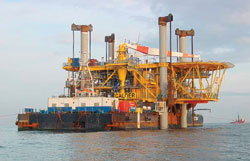 Technology from Europe: Technology from Europe:
The Netherlands
Suction-pile technology simplifies platform installation
Suction Pile Technology bv (SPT), a subsidiary of the Volker Wessels Stevin group NV, has successfully installed the Calder platform as part of Burlington Resources Irish Sea Ltd.’s Rivers field development project in the East Irish Sea, in 37-m water. Genesis Oil and Gas Consultants Ltd. contracted SPT for the installation work scope, including design of the suction piles, grillage and seafastening, fabrication of the suction piles and installation of the complete platform based on SPT’s proprietary SIP II concept. The platform is an unmanned facility and has a 680-mt topside weight, including six slots, temporary shelter, helideck, and a remote operating and shutdown system powered by an electrical umbilical.
The suction piles are 9.25 m in diameter and penetrated 5.5 m into the dense sands. The platform deck, built in Teesside on the North East UK coast was assembled on the SPT barge Pontra Maris and towed to Holyhead, a journey of 10 days. The platform was then towed out to the field. On arrival, actual installation time took only 40 hr, including setting up on the anchors, cutting of the seafastening, lowering the legs, installing the suction piles, lifting the deck and removing the Pontra Maris, followed by an ROV survey.
 |
Lowering the legs of the Calder platform during suction-pile installation.
|
|
SPT was responsible for provision of all marine and special installation equipment, including tugs, installation barge, suction pumps, strand jacks, positioning equipment, etc. The same SIP II concept will be used by Murphy Oil for its West Patricia development offshore Sarawak in 40-m water, with 1,800-mt topside weight. This platform includes a compression facility and has six slots.
SPT has developed four SIP concepts mainly to reduce installation costs using standard tugs and a flat top barge and rented installation equipment. The SIP installation spread is relatively cheap – i.e., about US $30,000/day, depending on market conditions; and the variance in costs is small even for the larger topsides up to 3,000 mt. Installation time of a SIP is normally less than for traditional piled platforms, as the suction piles are simultaneously installed in a matter of a couple of hours. Mudmats and leveling equipment are not needed as this is incorporated within the suction piles. SIPs do not depend on availability of heavy-lift barges or drill rigs, so they offer a lot of scheduling flexibility.
SIP I, III and IV are more suitable for marginal fields requiring topsides up to 600 mt and in maximum 100-m water. SIP III is a mono-pile or mono-tower jacket structure with two braces 90° apart, using three suction piles. It is transported on the corner of a flat-top barge supported by three transport beams and is lowered using strand or chain jacks. SIP IV is a mono-tower jacket structure with 3 – 4, legs using three suction piles as the foundation. 
|

 Technology from Europe:
Technology from Europe:

